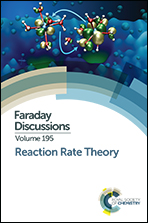Proton-coupled electron transfer reactions: analytical rate constants and case study of kinetic isotope effects in lipoxygenase
Abstract
A general theory has been developed for proton-coupled electron transfer (PCET), which is vital to a wide range of chemical and biological processes. This theory describes PCET reactions in terms of nonadiabatic transitions between reactant and product electron–proton vibronic states and includes the effects of thermal fluctuations of the solvent or protein environment, as well as the proton donor–acceptor motion. Within the framework of this general PCET theory, a series of analytical rate constant expressions has been derived for PCET reactions in well-defined regimes. Herein, the application of this theory to PCET in the enzyme soybean lipoxygenase illustrates the regimes of validity for the various rate constant expressions and elucidates the fundamental physical principles dictating PCET reactions. Such theoretical studies provide significant physical insights that guide the interpretation of experimental data and lead to experimentally testable predictions. A combination of theoretical treatments with atomic-level simulations is essential to understanding PCET.
- This article is part of the themed collection: Reaction Rate Theory

 Please wait while we load your content...
Please wait while we load your content...